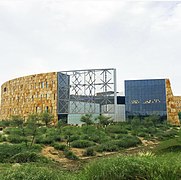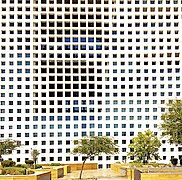Qatari art
| Part ofa serieson the |
| Culture of Qatar |
|---|
 |
| History |
| Languages |
| Cuisine |
| Religion |
| Musicandperforming arts |
| Sport |
The modernQatariartmovement emerged in the mid-20th century, as a result of the new-found wealth acquired from oil exports and the subsequent modernization of Qatari society. Because ofIslam's non-inclusive stance ofdepictions of sentient beingsinvisual arts,traditionalfigurative arthistorically played an insignificant role in the country's culture. Other visual art forms such as calligraphy, architecture, and textiles were more highly regarded in Qatari tradition.[1]
Modern visual arts
[edit]Origins
[edit]
Historically,figurative artwas not a feature of Qatari society due to Islamic traditions, and as a result, illustrative art forms such aspaintingsanddrawingswere rare. Instead, othervisual artforms such asarchitecture,calligraphyandtextileswere more highly valued.[1]However, during the oil boom in the 1950s and 1960s, figurative art began to gain popularity, with common themes focusing on Islamic and Arabic heritage.[2]
TheMinistry of Educationplayed a significant role in promoting art education in the 1950s by integrating it into the school curriculum and providing facilities for art workshops. In this vein, the ministry developed plans and programs to improve art teaching methods and enlisted skilled educators in the field. Additionally, it organized both local and national art exhibitions and provided educational resources such as films showcasing famous artists' works and various artistic techniques. Art education textbooks focusing on art appreciation, art history, and teaching methods were also introduced to teacher training institutes. The first nation-wide student art exhibition in 1961 showcased the creativity of Qatari students, many of whom later became notable artists.[3]
TheAl Jasrahneighborhood, located near the well-knownSouq Waqif,was the hub of Qatari cultural life in the 1950s. It was home to significant families closely linked to the rulers and other tribes, and it became a meeting place for several artists, including:Jassim Zaini(1943–2012), who is often regarded as the founder of the modern art movement,[4]Yousef Ahmad,Hassan Al Mulla,Ali Hassan, Salman Al-Malik, and Mohammed Al-Jaida, among others. Their childhood stories and shared passion for art would, many years later, lead to the establishment of the first art group in Qatar, The Three Friends, followed by the Qatar Fine Arts Society.[5]
In the 1950s, the first social and cultural clubs, such as the Al-Oruba Club and the Al-Nasr Club, emerged. However, it wasn't until the Al Jasrah Social and Cultural Club was established in 1971 that these clubs began to contribute significantly to the art scene.[5]
Early development initiatives
[edit]As an initiative to develop the local artist base, the Ministry of Education began offering scholarships to study art abroad. Jassim Zaini became the first Qatari art student to study abroad on a scholarship in 1962 after he enrolled in theUniversity of Baghdad.[6]Further artists were sent abroad on art scholarships during the 1960s and 1970s, includingWafika Sultan,Hassan Al Mulla and Yousef Ahmad. The latter became the first artist to receive anM.A.in 1981.[7]Wafika Sultan emerged as the first professional female visual artist after graduating in 1974.[8]
Initially, few Qatari artists had formal fine arts education, with many pursuing art through various academic routes. This changed with the establishment ofQatar Universityin 1973 and the eventual introduction of the Art Education Department in 1986, which produced generations of graduates. Early beneficiaries of Qatar University's arts program include artists Wafa Al-Hamad, Badriya Al-Kubaisi, and Khawla Al-Mannai.[5]
The 'Free Studio' training program became an introductory gateway for university students, conceptualized by the Ministry of Education in the late 1960s and operational by the early 1980s under the Ministry of Information. Prominent Egyptian artistGamal Kotbplayed a key role in developing training programs for the studio. The studio offered courses and public lectures, with state support providing salaries for participants and inviting prominent artists for training sessions.[5]
Initial growth
[edit]
Art exhibitionswere held under the auspices of the Ministry of Education until 1972.[9]The limited art exhibitions at the time were held in venues like the Gulf Hotel, theNational Museum of Qatar,the Qatar Fine Arts Society, and clubs like Al Jasra andAl Gharrafa,with no private galleries existing at the time. Notable early exhibitions include the UNESCO Art Exhibition showcasing European painters from 1900 to 1925, the Leonardo da Vinci Manuscripts Exhibition in 1972, and the Watercolor Exhibition in 1976.[5]Yousef Ahmad was the first artist to hold asolo exhibitionin 1977.[7]The Department of Culture and Arts inaugurated the country's first art gallery, located in the Visual Arts Centre, in 1977 under its directorNasser Al-Othman.[3]
Several art institutions and cultural clubs began to form in the 1970s; the most prominent among these was the Al Jasrah Cultural Club, which was formed in 1971. As the art movement in Qatar began to mature, the Al Jasrah Cultural Club took on the responsibility of uniting talented artists.[5]Jassim Zaini was a member of the club's administrative committee in addition to his role as an art education supervisor at the Ministry of Education. Through his position and involvement in Al Jasrah Club, Zaini gathered many emerging talents, providing them with guidance in aspects such as color, line, and space. Among his students were several who went on to become prominent artists in the industry, including Yousef Ahmad, Salman Al Malik and Hassan Al Mulla.[10]The club was officialized in 1974 at a ceremony held in Al Jasrah Hall.[5]
Following the founding of Al Jasrah Club, several other art institutions were established. In 1976, Mohammed Al-Mannai opened the Cultural Center.[5]This was followed by Qatari government's establishment of the Department of Culture and Arts, which was later renamed the National Council for Culture, Arts, and Heritage, also in 1976.[11]Finally, in 1977, the newly established Department of Culture and Arts, under its first director Nasser Al-Othman, opened the Visual Arts Center to the public. These institutions organized international exhibitions in Qatar, showcasing the work of Qatari and regional artists and evoking public interest in the visual arts.[5]
In 1977, Yousef Ahmad, Hassan Al Mulla, and Muhammad Ali founded the country's first art group, "The Three Friends Group".[3]After chartering a bus, they traveled across Qatar, holding small-scale exhibitions where they displayed their works.[5]The Qatar Fine Arts Society was established in 1980 to promote the works of Qatari artists and held its first exhibition in 1981.[9]
Growth of women artists
[edit]Development initiatives exclusive to Qatari women artists began in 1980 with the official opening of The Free Studio, an arts education center under the Ministry of Information. With the aim of encouraging artistic talent through courses and public lectures, the center operated on a schedule that allocated two days for female students and three days for male students for two hours daily throughout the year. The first women's session took place on 6 June 1980 and was supervised byBahrainiartist Najah Al-Madani, who played a significant role in educating many women artists. Many fundamental skills were taught to both men and women, includingdrawingwith pencil and pastels,oil painting,Arabic calligraphy,andceramics.[5]
The state's support for The Free Studio included providing generous stipends for enrolled students, ensuring competent teachers, and facilitating student participation in exhibitions organized by the Department of Culture and Arts. Esteemed international artists were also invited to conduct training courses for the studio participants. Between 1981 and 1985, the studio produced several female artists, including Wafa Al-Hamad, Maryam Abdullah and Jamila Al-Shuraim. Many of these students, including Hessa Al-Muraikhi, who later became the supervisor of the women's section, continued their artistic practice after their training at the studio.[5]
In 1981, an art workshop was opened for women with the aim of providing them with an opportunity to hone their artistic skills.[12]In December 1982, the country's first art exhibition for women was held.[3]
Later developments
[edit]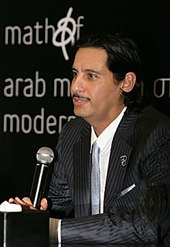
Five main art movements emerged in the country by the late 20th century:surrealism,realism,expressionism,abstract art,andcalligraphy.[3]
In 1986,Qatar Universityestablished its Art Education Department. In the beginning, the program did not have many participants, but it gradually became a more popular field of study over time. The initial 1986 class only had two women students. This increased to eight in 1987 and eventually exceeded 20 female students a few years later. The curriculum included both theoretical courses (covering education, art history, and criticism) and practical courses focused on various art forms (drawing, painting, ceramics, design).[5]
A member of the ruling family,Hassan bin Mohamed bin Ali Al Thani,has been an instrumental figure in developing Qatar's modern art industry since the 1980s.[13]Among his art-related activities was establishing his own museum which doubled as a residency space for Doha-based artists in 1994, and establishing theMathaf: Arab Museum of Modern Artin 2010 to which he donated his entire art collection, which he had begun assembling in 1986.[14]
In 1998, Department of Culture and Arts was integrated into the newly established National Council for Culture, Arts and Heritage.[15]
The early 2000s saw a significant increase in female artistic talent in Qatar. Many women artists, such as Nadia Al-Mudihki, Amal Al-Atham, and Hanadi Darwish, assumed leadership roles in art centers. Hanadi Darwish, for example, is a plastic artist who became the chairwoman of the Girls Creativity Center, which is under the supervision Ministry of Youth. These centers provided emerging women artists with opportunities for artistic development through various training centers and international courses.[5]
When a quartet comprising Saudi Arabia, the UAE, Bahrain, and Egyptsevered all tieswith and imposed a blockade of Qatar on 5 June 2017,[16]Qatari artist Ahmed Al-Maadheed created an illustration known asTamim Almajd(2017), which translates to "Tamim the Glorious".A simple black and white sketch of EmirTamim bin Hamad Al Thani,beneath which is the text "Tamim Almajd"in the style ofArabic calligraphy,the illustration has become symbolic of Qatari nationalism. During the diplomatic spat, the image was displayed prominently on buildings, in media and art in Qatar.[17]
Art museums
[edit]UponKhalifa bin Hamad Al Thani's accession to the throne in 1972, he drew up plans for a national museum in order to document the country's heritage and traditions. It was decided that the building would enclose theOld Amiri Palace,a dilapidated early-20th century palace previously occupied by Qatar's former emir,Abdullah bin Jassim Al Thani.[18]Originally named the Qatar National Museum, it was inaugurated on 23 June 1975.[19]This museum was replaced by another similarly named museum, theNational Museum of Qatar,built on the same site and opened on 28 March 2019. The building was designed by architectJean Nouvelwho was inspired by thedesert rose crystal,which can be found in Qatar.[20]
Qatar Museumswas established in 2005 to oversee the construction and maintenance of all museums and collections in Qatar.[21]Two major museums lead the institution: theMuseum of Islamic Artopened in 2008,[22]and theMathaf: Arab Museum of Modern Art,opened in Education City byQatar Foundationin 2010.[23]
At the 2022Doha Forum,Qatar Museum's Chairperson, SheikhaAl Mayassa bint Hamad bin Khalifa Al Thani,revealed plans for a further three museums:[24]The first, the Art Mill, located on the site of a historic flour mill, a centre designed byAlejandro Aravenaof Elemental,[25]will accommodate presentation facilities for artistic media and for present day art, as well as spaces for educational activities and internship programs, workrooms, a centre for the cultural industries of Qatar, the Dhow Centre, as well as gardens. The second, the Lusail Museum, designed by architectJacques Herzog of Herzog & de Meuron,[26]a museum of more than 52,000 square meters will comprise different cultural spaces and accommodate the world's most extensive exhibition of orientalist art. The third newly proposed museum, the Qatar Auto Museum, will feature permanent galleries centered around the automobile and its development in Qatar.[27]
Textiles
[edit]Weaving and dyeing
[edit]
Weavinganddyeingplayed a substantial role inBedouinculture.[28]The process of spinning sheep's and camel's wool to produce cloth was laborious. The wool was first disentangled and tied to a bobbin, which would serve as a core and keep the fibers rigid. This was followed by spinning the wool by hand on a spindle known as anoul.[29]They were then placed on a verticalloomconstructed from wood whereupon women would use a stick to beat theweftinto place.[30]
The resulting cloths were used in rugs, carpets, and tents. Tents were usually made up of naturally colored cloth, whereas rugs and carpets used dyed cloth, mainly red and yellow.[30]The dyes were made from desert herbs, with simple geometrical designs being employed. The art lost popularity in the 19th century as dyes and cloth were increasingly imported from other regions in Asia.[30]
Embroidery
[edit]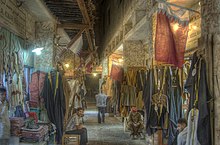
A simple form of embroidery practiced by Qatari women was known askurar.It involved four women, each carrying four threads, who braided the threads on articles of clothing, mainlythawbsorabayas.The braids, varying in color, were sewn vertically. It was similar to heavychain stitchembroidery.[30]Gold threads, known aszari,were commonly used. They were usually imported fromIndia.[31]
Another type of embroidery involved the designing of caps calledgohfiahs.They were made from cotton and were pierced with thorns from palm trees to allow the women to sew between the holes. This form of embroidery declined in popularity after the country began importing the caps.[31]
Khiyat al madrasa,translated as 'school embroidery', involved the stitching of furnishings bysatin stitching.Prior to the stitching process, a shape was drawn onto the fabric by a skilled artist. The most common designs were birds and flowers.[1]
Architecture
[edit]Forts
[edit]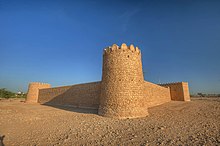
The numerous forts found throughout the Qatari peninsula are a testament to the country's ancient construction methods.[32]Most forts were constructed using mainlylimestone,with other constituents such as mud and clay brick also being used. A type of mixture consisting of mud and clay brick known locally aslubnahwas sometimes used in the construction of forts, such as inAr Rakiyat Fort.[33]
Traditional architecture
[edit]Most traditional houses in the capitalDohawere tightly packed and arranged around a central courtyard. Some rooms were situated in the courtyard, most often including amajilis,bathroom and store room. The houses were made from limestone quarried from local sources. Walls surrounding the compounds were made up of compressed mud, gravel, and small stones. As they were heavily susceptible to natural erosion, they were protected bygypsumplaster.Mangrove poles wrapped in jute rope provided structural support for the windows and doors.[34]
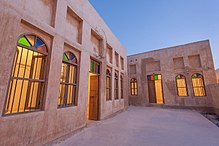
Roofs were typically flat and were supported by mangrove poles. The poles were covered with a layer of split bamboo and a palm mat locally calledmanghrour.The mangrove poles often extended past the exterior walls for decorative purposes. Doors were made of metal or wood. Colored glass employing geometrical designs was sometimes used in windows.[34]The local architecture shows the use of the reddish stone of Qatar, as well as little use of wood due to the scarcity of resources in the region.
Several methods were used in traditional architecture to alleviate the harsh climate of the country. Windows were seldom used in order to reduce heat conduction.[34]Thebadgheerconstruction method allowed air to be channeled into houses for ventilation purposes. This was accomplished by several methods, including horizontal air gaps in rooms and parapets, and vertical openings in wind towers calledhawayawhich drew air into the courtyards. Wind towers, however, were not as common in Doha as they were in other parts of the country.[35]
Shortly after Qatar gained independence, many of the districts of old Doha, includingAl Najada,Al Asmakh, andOld Al Hitmi,faced gradual decline, and as a result, much of their historical architecture has been demolished.[36]A number of schemes have been taken to preserve the city's cultural and architectural heritage, such as theQatar Museums Authority's 'Al Turath al Hai' ('living heritage') initiative.[37]
Modern architecture
[edit]Qatar in the past two decades has pinpointed its place on the world map with prominent global landmarks includingEducation Citywhich showcases architecture from numerous architects includingRem Koolhaaswho designed theQatar National Libraryduring 2018 and theQatar Foundationheadquarters back in 2014.[38]
Among Qatar's notable architects is Japanese architectArata Isozakiwho contributed towards designing countless buildings in Education City,[39]including theQatar National Convention Center(QNCC), the Liberal Arts and Science Building (LAS) and the Qatar Foundation Ceremonial Court.[38]
Qatar's art initiatives have expanded tremendously in recent years with the opening of massive great projects including theDoha Fire Stationwhich exhibits art at the heart of the city.[40]
Arts and museums have played a pivotal role in improving Qatar's tourism and inviting people to understand Qatar's history and heritage with the openings of theNational Museum of Qatar,Mathaf: Arab Museum of Modern Art,Msheireb Museumsand theMuseum of Islamic Arts.[40]
Sheikha Al-Mayassa bint Hamad bin Khalifa Al-Thanihas played a significant role in bringing art to Qatar,[41]particularly with the latest art installations at theHamad International Airport(HIA) showcasing pieces of work by numerous global artists in collaboration withQatar Museums Authority.[42]
Under the guidance of the CEO of Qatar Foundation,Sheikha Moza bint Nasser,[43]Education Cityhas become a home for modernistic buildings originating from worldwide architects contributing to the building of schools, universities, offices, and accommodations for the community.[38][44]
Examples of modern architecture
[edit]- Qatar National Convention Center(2011) designed byArata Isozaki[45]
- Qatar Foundation Ceremonial Court (2007) designed byArata Isozaki[46]
- Qatar Foundation Headquarters (2014) designed byRem Koolhaas[47]
- Northwestern University in Qatar(2017) designed byAntoine Predock[48]
- Carnegie Mellon University in Qatar(2008) designed byRicardo LegorretaandVictor Legorreta[49]
- Virginia Commonwealth University in Qatar (1998) designed by Mimar Consult[39]
- Weill Cornell Medical College in Qatar(2003) designed byArata Isozaki[50]
- Liberal Arts and Science building (2004) designed byArata Isozaki[51]
- Georgetown School of Foreign Service in Qatar (2010) designed byRicardo LegorretaandVictor Legorreta[52]
- Texas A&M University in Qatar (2007) designed byRicardo LegorretaandVictor Legorreta[53]
- Qatar Academy(1997) designed by Al Seed Consultant and Design Studio
- Awsaj Academy (2011) designed byJames Cubittand Partners
- Qatar Science and Technology Park (2009) designed byWoods Bagot[54]
- Strategic Studies Center (2014), also known as Think Bay designed byOffice for Metropolitan Architecture(OMA)
- Qatar National Library(2018) designed byRem Koolhaas[55]
- Sidra Medical and Research Center(2017) designed byPelli Clarke PelliArchitects[56]
- Al Shaqab(2019) designed byLeigh & Orange Architects[57]
- Student Center (2012) designed byRicardo LegorretaandVictor Legorreta
- Qatar Faculty of Islamic Studies (2014) designed by Mangera Yvars Architects[58]
- Mathaf: Arab Museum of Modern Art(2010) designed by Jean-Francois Bodin[59]
-
Qatar Faculty of Islamic Studies designed by Mangera Yvars Architects
-
Qatar FoundationHeadquarters designed byRem Koolhaas
-
Qatar National Librarydesigned byRem Koolhaas
Prehistoric art
[edit]
Ancientrock carvingshave been discovered in eight separate locations in Qatar:Jebel Jassassiyeh,Jebel Fuwayrit,Freiha,Al Ghariyah,Al Jumail,Simaisma,Al Wakrahand Al Qassar. Most of these sites were discovered by Danish archaeological teams in the 1950s and 1960s.[60]The carvings are classified in several categories, including human and animal representation, boat representation,cup-marks,large cavities, geometric designs, tribal marks, and hand- and footprints.[61]
A large number of rock carvings were discovered in Jebel Jassassiyeh, in northeast Qatar, in 1961. Variations in motifs and techniques indicate that the carvings were made through various historical periods.[62]Cup marks are the most common forms of art among the nearly 900 carvings. Other carvings include ships, animals, foot-prints and tribal marks (known aswasum).[60][63]Different animals are depicted, such as ostriches, turtles, and fish. A large number of the carvings illustrate boats, and this is the only site in Qatar where boat depictions have been recorded. The boats are of different sizes and types, and some containoarswhile others do not.[64]
Geometrical designs were recorded at Freiha in four places. They measure 11 to 15 cm in width and 11 to 12 cm in height. Danish archaeologistPeter Globbelieved that they were carved by an ancient fertility cult.[65][66]This theory was disputed by Muhammad Abdul Nayeem, who believes that they are simply abstract symbols or tribal marks.[65]
Notable artists
[edit]- Jassim Zaini,probably the most important Qatari artist, founding the modern movement[6]
- Faraj Daham, a Qatari artist and founding member of the Qatari Fine Arts Society,[67]his work addresses social and political topics in painting and installation, often using recycled material and raw material
- Yousef Ahmad,a Qatari painter, art collector and author[68]
- Wafika Sultan Al-Essa,the first professional Qatari female artist[8]
- Salman Al-Malik, a Qatari artist[69]
- Hassan Al Mulla,a Qatarisurrealistpainter[70]
See also
[edit]- Culture of Qatar
- Public art in Qatar
- Collecting practices of the Al-Thani Family
- Rock art in Qatar
- Qatari literature
Art galleries in Qatar
[edit]References
[edit]- ^abcA. Abu Saud (1984), p. 140
- ^A. Abu Saud (1984), p. 141
- ^abcde"رحلة الفن التشكيلي بدولة قطر أ.د. ليلي حسن علام".Aljasra Culture Magazine. 16 June 2010.Retrieved30 July2015.
- ^"Artist honoured: Source of inspiration".thepeninsulaqatar.2012-12-26.Retrieved2022-12-02.
- ^abcdefghijklmnDagher, Charbel(10 November 2022)."نشأة الفَنّ التشكيلي في قطر".Doha Magazine(in Arabic). Ministry of Culture (Qatar).Retrieved15 June2024.
- ^ab"Jassim Zaini".Mathqaf.2021-12-15.Retrieved2022-11-25.
- ^ab"Yousef Ahmad".RAK ART FOUNDATION.Retrieved2022-11-25.
- ^ab"Qatar's pioneer of modern art Wafika Sultan Saif Al-Essa".ILoveQatar.net.Retrieved15 June2024.
- ^abA. Abu Saud (1984), p. 142
- ^Fathi, Osama (5 July 2020)."الفنان القطرى جاسم زينى ، فن حديث بروح تعبيرية"(in Arabic). Arab22.Retrieved15 June2024.
- ^"Brief History".Ministry of Culture (Qatar).Retrieved16 June2024.
- ^A. Abu Saud (1984), p. 144
- ^"Public Art in Qatar - Hassan bin Mohammed Al Thani | Qatar Creates".qacreates.Retrieved2022-12-02.
- ^John Zarobell (2017).Art and the Global Economy.University of California Press. p. 165.ISBN9780520291539.
- ^"Culture & Arts".Consulate General of the State of Qatar. Archived fromthe originalon 22 July 2015.Retrieved21 July2015.
- ^"Qatar crisis: What you need to know".BBC News.2017-06-06.Retrieved2023-01-25.
- ^"'Tamim the Glorious' enthrals Qatar ".The Hindu.Agence France-Presse. 3 August 2017.Retrieved23 August2018.
- ^"Wherefore Art Thou Qatar?".The Business Year. 2014. Archived fromthe originalon 8 March 2016.Retrieved16 June2024.
- ^Mohammed Hassan Al-Kuwari; Maryam Khulaifi; Jamila Abdulla Ahmed; Sawsan Al-Haddad (2013)."دليـل المؤسسات الثقافية في قطر (Directory of Cultural Institutions in Qatar)"(PDF)(in Arabic).Ministry of Culture, Arts and Heritage.p. 12. Archived fromthe original(PDF)on 2015-12-22.
- ^Powell, Jim (30 March 2019)."The 20 photographs of the week".The Guardian.Retrieved16 June2024.
- ^"About us".Qatar Museums.Retrieved3 May2024.
- ^Lomholt, Isabelle (2022-11-23)."Museum of Islamic Art, Doha Qatar".e-architect.Retrieved2022-11-25.
- ^McManus, David (2010-09-29)."Mathaf: Arab Museum of Modern Art Qatar".e-architect.Retrieved2022-11-25.
- ^"Qatar Reveals Ambitious Plans for Three New Cultural Institutions".artforum.2022-03-28.Retrieved2023-01-17.
- ^"How to turn a flour mill into a world-class museum: architect Alejandro Aravena on his mammoth Qatar project".The Art Newspaper - International art news and events.2022-12-13.Retrieved2023-02-09.
- ^"OMA, Herzog & de Meuron and ELEMENTAL to design three major new museums in Qatar".World Architecture Community.Retrieved2023-02-09.
- ^Kinsella, Eileen (2022-03-28)."Qatar Announces It Will Build the World's Largest Museum of Orientalist Art Along With Two Other Starchitect-Designed Institutions".Artnet News.Retrieved2022-08-12.
- ^"Bedouin women face-to-face with patriarchal culture".Your Middle East.2012-10-02.Retrieved2023-01-17.
- ^A. Abu Saud (1984), p. 135
- ^abcdA. Abu Saud (1984), p. 136
- ^abA. Abu Saud (1984), p. 137
- ^"Forts in Qatar".Qatar Museums.Retrieved21 July2015.
- ^The Syriac Writers of Qatar in the Seventh Century(2014), p. 32
- ^abc"Traditional domestic architecture of Qatar".Origins of Doha. 15 February 2015.Retrieved21 July2015.
- ^"Gulf architecture".catnaps.org.Retrieved21 July2015.
- ^Djamel Bouassa."Al Asmakh historic district in Doha, Qatar: from an urban slum to living heritage".Journal of Architectural Conservation.20(1): 1–14.Retrieved10 July2015.
- ^"The Winners of the Old Doha Prize Competition Announced".Marhaba. 26 November 2013.Retrieved10 July2015.
- ^abcJodidio, Philip. (2014).Education city: building foundations for the future.Doha: Qatar Foundation, Capital Projects Directorate.ISBN9788416142361.OCLC899565075.
- ^abBonilla, Leslie."Pearls, Souqs and Daggers: Inside the Hidden Elements of Education City Architecture".The Daily Q.Retrieved2023-01-17.
- ^ab"Visit Qatar | Discover a Unique Destination".visitqatar.qa.Retrieved2019-04-15.
- ^"HE Sheikha Al Mayassa Al Thani, Chairperson of Qatar Museums, is the Guest Editor of the November 2022 Issue of Vogue Arabia".Vogue Arabia.2022-11-01.Retrieved2022-12-02.
- ^Falconer, Morgan (2002-04-30).Butt, Hamad.Oxford Art Online. Oxford University Press.doi:10.1093/gao/9781884446054.article.t097571.
- ^"Her Highness Sheikha Moza bint Nasser | Qatar Foundation".qf.org.qa.Retrieved2022-11-30.
- ^"Explore Qatar's Education City".qf.org.qa.Retrieved2022-11-30.
- ^"Qatar National Convention Centre / Arata Isozaki".ArchDaily.2013-09-10.Retrieved2022-11-25.
- ^"Ceremonial Court and the Ceremonial Green Spine".visitqatar.Retrieved2022-11-25.
- ^"QF Conversation: Rem Koolhaas".Qatar Foundation.2017-11-08.Retrieved2022-11-25.
- ^"HBKU Carnegie Mellon / Legorreta + Legorreta".ArchDaily.2014-12-12.Retrieved2022-11-25.
- ^"Home in Qatar - Carnegie Mellon University | CMU".cmu.edu.Retrieved2023-01-17.
- ^"The Building | Weill Cornell Medicine - Qatar".qatar-weill.cornell.edu.Retrieved2022-11-30.
- ^"Liberal Arts and Science Building, Doha Qatar".archnet.org.Retrieved2023-01-17.
- ^"Georgetown University / LEGORRETA".ArchDaily.2018-11-05.Retrieved2023-01-17.
- ^"Texas A&M Engineering Building".qatar.tamu.edu.Retrieved2023-01-17.
- ^"Qatar / Woods Bagot".ArchDaily.2013-07-31.Retrieved2022-11-30.
- ^"Our Building | Qatar National Library".qnl.qa.Retrieved2022-11-30.
- ^"Sidra Medical and Research Center / Pelli Clarke Pelli Architects".ArchDaily.2019-05-02.Retrieved2022-11-30.
- ^"Al Shaqab Equestrian Academy".Leigh & Orange Architects.Retrieved2022-11-30.
- ^"Qatar Faculty of Islamic Studies by Mangera Yvars Architects | Universities".Architonic.Retrieved2022-12-02.
- ^"Mathaf: Arab Museum of Modern Art".universes.art.Retrieved2022-11-30.
- ^abAbdul Nayeem (1998), p. 220.
- ^Abdul Nayeem (1998), p. 231.
- ^Abdul Nayeem (1998), p. 221.
- ^Bibby, Geoffrey (1965). "Arabian Gulf archaeology".Kuml:104.
- ^Abdul Nayeem (1998), p. 233.
- ^abAbdul Nayeem (1998), p. 256.
- ^Glob, Peter (1957). "Prehistoric discoveries in Qatar".Kuml:176.
- ^"Faraj Daham".Qatar Museums Authority. Archived fromthe originalon 27 April 2015.Retrieved21 July2015.
- ^Touati, Samia."Biography of Yousef Ahmad".Mathaf Encyclopedia of Modern Art and the Arab World.Retrieved21 July2015.
- ^Nicolai Hartvig (6 January 2012)."Qatar Looks to Balance Its Arts Scene".The New York Times.Retrieved30 November2015.
- ^Asian Art Biennale Bangladesh.The Academy. 2003.ISBN9789845550277.
Al-Mulla is the best known Qatari artist who took Surrealism as a method of expression.
Bibliography
[edit]- Abdul Nayeem, Muhammad (1998).Qatar Prehistory and Protohistory from the Most Ancient Times (Ca. 1,000,000 to End of B.C. Era).Hyderabad Publishers.ISBN9788185492049.
- Abu Saud, Abeer (1984).Qatari Women: Past and Present.Longman Group United Kingdom.ISBN978-0582783720.
- Kozah, Mario;Abu-Husayn, Abdulrahim;Al-Murikhi, Saif Shaheen; Al-Thani, Haya (2014).The Syriac Writers of Qatar in the Seventh Century(print ed.). Gorgias Press LLC.ISBN978-1463203559.




